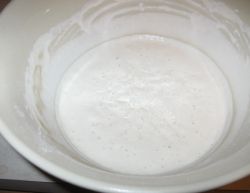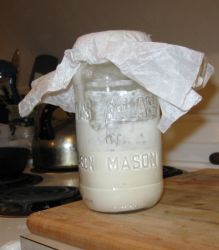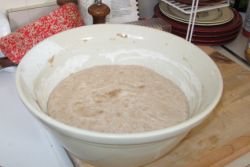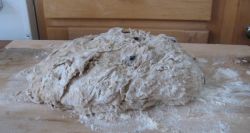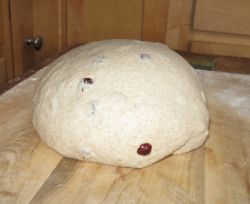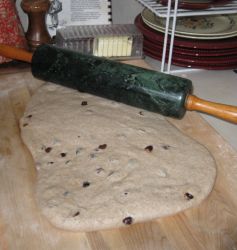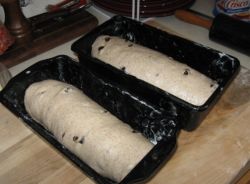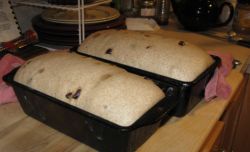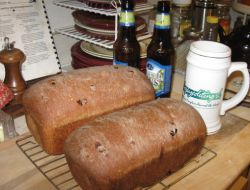 |
 |
||||||||||||
Bread DemoFebruary 04, 2011 I made bread this week, which isn't unusual, but I also took pictures of various stages in the process, which is. Here are some of them, with accompanying explanations.
Most of the bread I make these days is raised with a sourdough starter. A jar of starter resides in my fridge (see pic on right). The morning of the day before I want to bake, I pour the starter into my big bread bowl, then whisk in a cup of very warm water and one and a half cups of unbleached white flour. After it's sat out on the counter for about 12 hours, it looks like the photo on the left. In warm weather, it takes less time. Then I stir or whisk the starter to get the bubbles out and pour half of it back into the jar. It goes back into the fridge to wait till I make bread again.
Then in goes about 1/4 cup oil or melted butter, 2 tablespoons honey (or molasses, maple syrup, or brown sugar -- something sweet), and enough flour to make a thick batter. I use a combination of whole wheat and white. It usually takes 3 cups or so. Then it stays out on the counter overnight, and then some, depending on the temperature. About 12 hours this time of year. The batter will rise and look lighter and more bubbly than it did the night before. Sorta like this (above). Next you stir down the batter, add a scant tablespoon of salt, 1/2 a teaspoon of baking soda, and (if you're like me and love bread with stuff in it, like raisins and chopped walnuts) add a couple handfuls of stuff. This time I used dried cranberries. Then start adding flour, whole wheat and/or white in whatever combination you want, until the batter becomes dough that you can knead.
On the left is what the dough looks like before you start kneading. On the right is what it looks like after you've been kneading for 10–12 minutes. Isn't it cool? This is why I'll never, ever let a machine do my kneading for me. Feeling the dough transform under my hands under my hands is just too magical.
The loafed dough on the left is ready to rise. On the right it's ready to bake. It took five or six hours to get from one stage to the other. The warmer the temperature, the faster it rises, but sourdough generally isn't nearly as fast as active dry yeast. Bake at 375 degrees F for about 35–40 minutes and this is what it looks like: Still Staff-of-Life with Beer Bottles and Stein.
|
|||||||||||||
Home - Writing - Editing - About Susanna - Bloggery - Articles - Poems - Contact Copyright ©
Susanna J. Sturgis. All rights reserved. |
|||||||||||||
